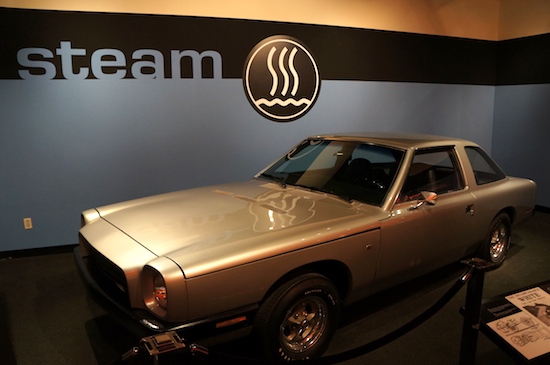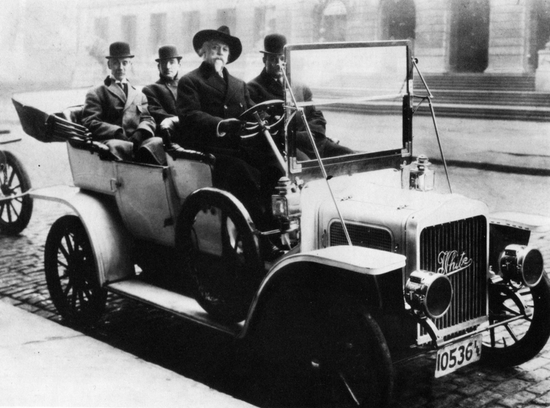Dutcher steam-powered car from 1974 at the Petersen Automotive Museum in Los Angeles [Photo: Matt Novak]

In 1969 California State Senator Nicholas Petris, a Democrat from Oakland, proposed a bill that would have banned the sale of any vehicle with a gasoline or diesel-powered internal combustion engine by 1975. Needless to say, that bill went nowhere quickly. But if such legislation had been taken seriously, what would have replaced the internal combustion engine? Well, in the 1970s California state legislators thought they had found the answer in cars that run on steam. Yes, steam.
When we think about the history of the automobile we often imagine the battle between the gas-powered cars that dominate our streets today and the electric car (or gas-electric hybrids) that have a rich history dating back to the turn of the 20th century. But few people remember the other technologies that fought hard for their place in the future, including steam.
Unlike the internal combustion engine of the gasoline-powered cars, steam-powered cars have an external combustion engine which is more efficient and has lower emissions. The steam-powered automobile may seem like a bit of a joke, but it was a serious contender for auto-supremacy at the dawn of the automobile. Of the 4,192 vehicles accounted for being produced in the United States in the 1900 Census, just 936 of them ran on gasoline, 1,575 were electric, and 1,681 ran on steam. Within less than two decades that distribution radically changed. About 99 percent of the 568,000 automobiles produced in 1914 America contained an internal combustion engine.
Model O Steamer in 1908 driven by William “Buffalo Bill” Cody [Source: The Car Solution by Gary Levine]

With the energy and pollution crises of the 1970s the low-emission external combustion engine saw renewed interest as a solution to the nation’s air quality problems — and especially those in smog-choked southern California.
Books like The Car Solution: The Steam Engine Comes of Age (1974) by Gary Levine and The Steam-Powered Automobile: An Answer to Air Pollution (1970) by Andrew Jamison presented the steam car as the the logical choice for a country that had in many ways built itself into a corner with infrastructure that catered to the automobile. For a nation grasping in the smog for any clear-sky answer, every technology was on the table.
Starting with legislation proposed in 1968, the state of California began experimenting with steam buses, contracting with companies to build three of them. All three were demonstrated in Sacramento on April 26, 1972. But only focusing on low emission buses wasn’t seen as doing enough to combat the smog. In 1972 the California Assembly passed legislation which contracted two companies to develop steam-powered cars: Aerojet Liquid Rocket Company of Sacramento and Steam Power Systems of San Diego.
The two companies took different approaches with their respective steam technologies. Aerojet installed a steam turbine into a Chevy Vega, while Steam Power Systems chose to build its Dutcher car (named for the company’s founder, Cornelius Dutcher) from scratch. The Dutcher car was finished and successfully tested in 1974 though neither car went into production. By 1975 the California Assembly was again back to buses, along with allusions in the press that these experiments with steam were little more than hand-outs to some of the contractors who just so happened to be major financial contributors to the state’s Democratic Party.
You can see a Dutcher test vehicle on display at the Petersen Automotive Museum in Los Angeles. The steam car is on loan from one of the better-known car collectors that zip around Southern California in eccentric vehicles: Jay Leno.
For all the efforts of companies and governments to get consumers excited about steam cars, the idea obviously never took off. The biggest problem with the steam-powered car? It pumped out less pollution, but was quite a fuel-hog. The fuel used in steam engines of the early 1970s was usually kerosene, but diesel was also an option. Naturally, the last thing people wanted when so many had to line up just to fill up their tanks was to use more energy than they already did.





